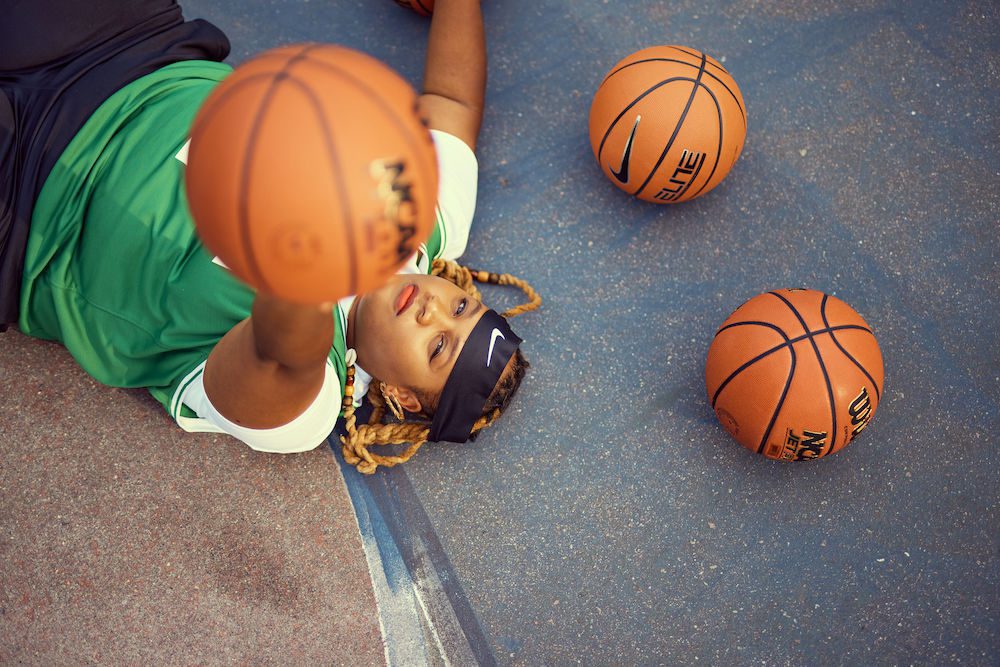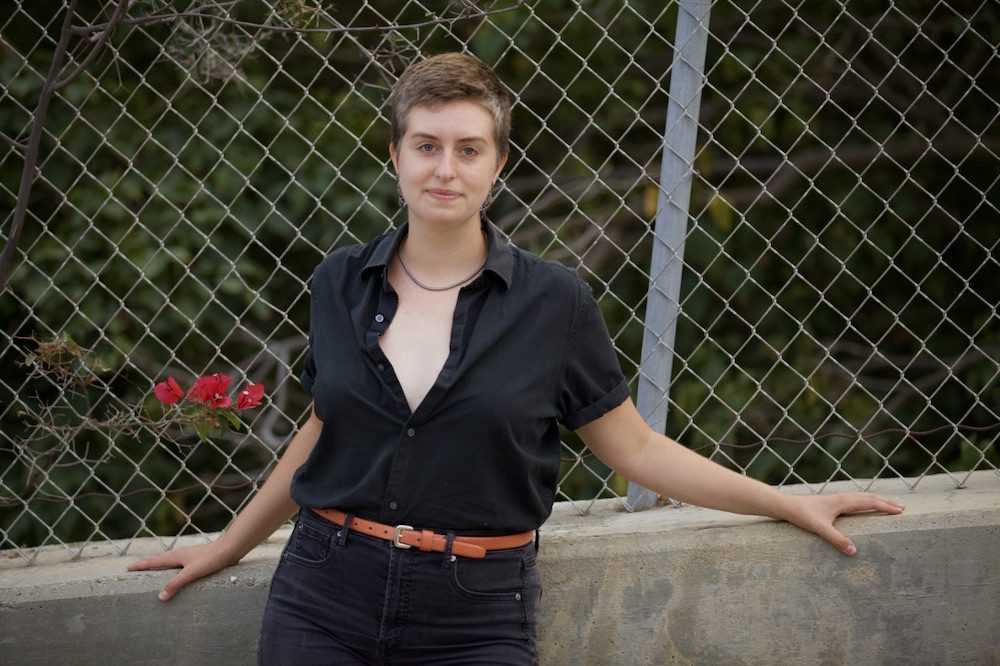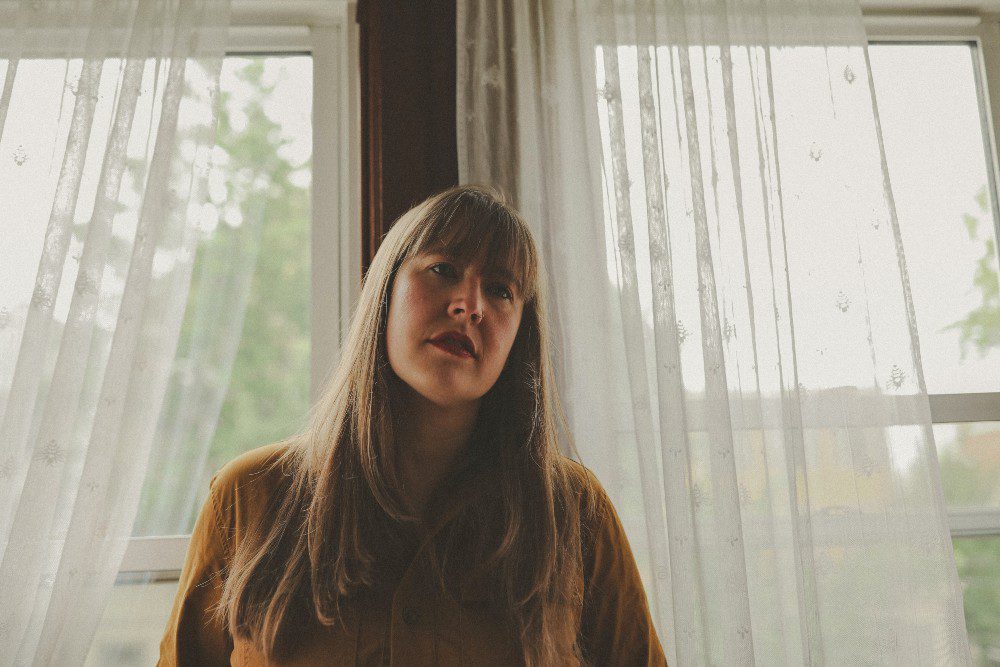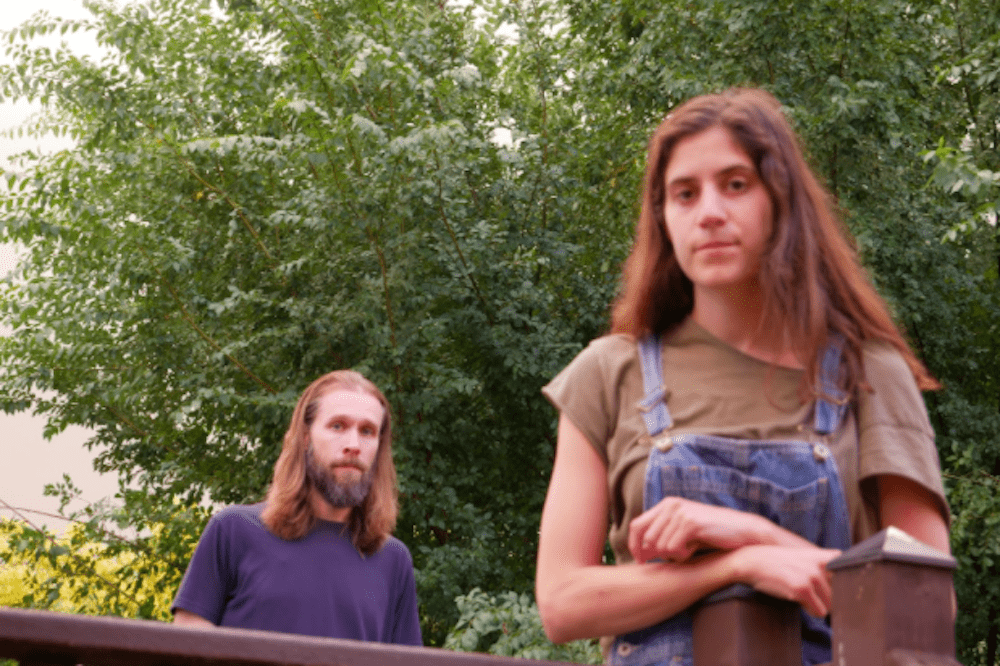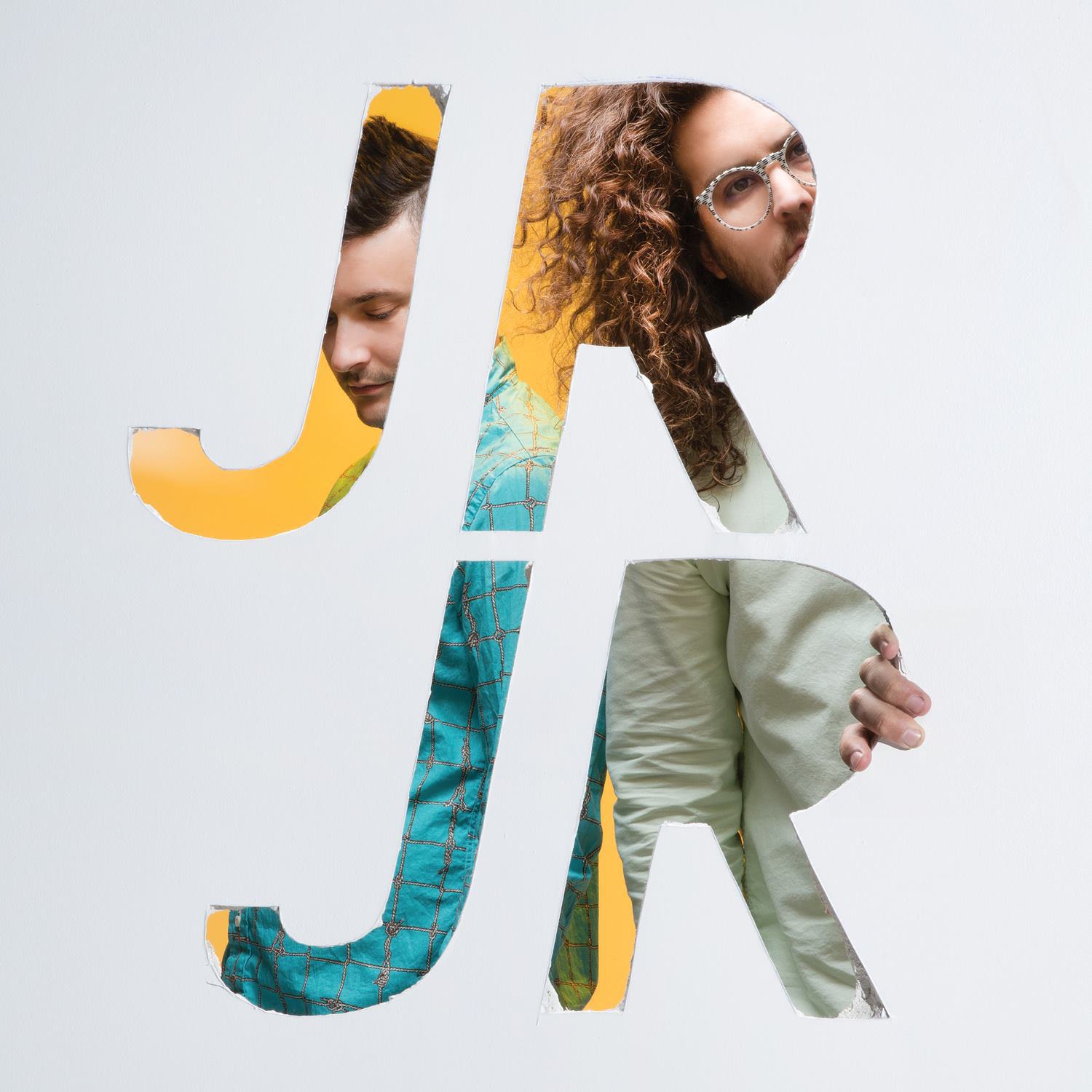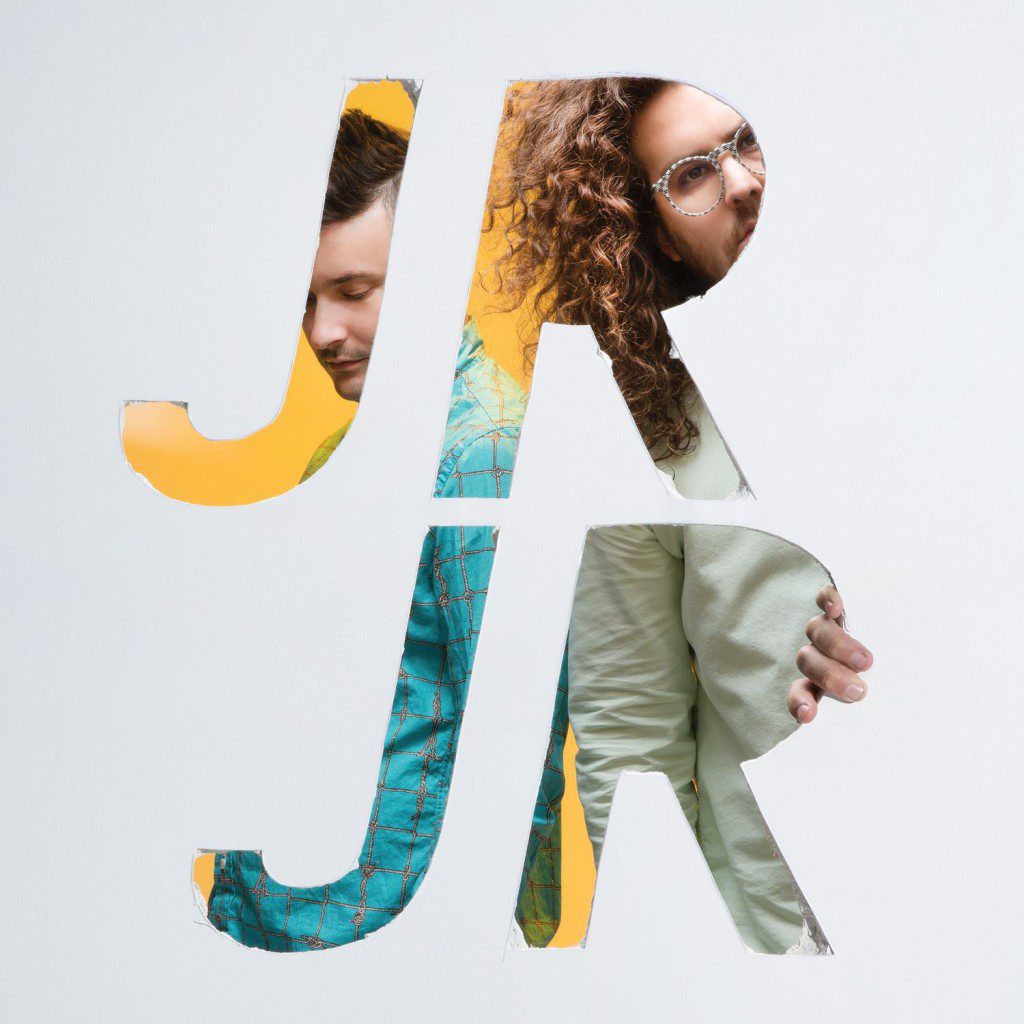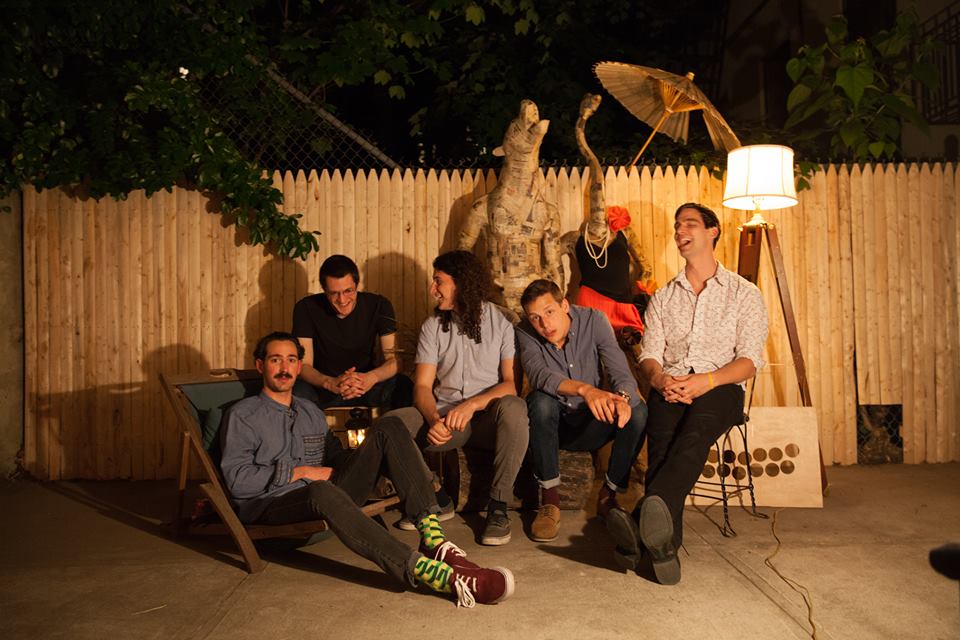

Boston-based singer-songwriter Alisa Amador refers to her forthcoming EP Narratives – out September 17th – as a “six-song survival kit,” offering her buoyant spirit up as a life raft. Her songcraft is deeply personal, examining her intersecting identities, but there’s something universally relevant about the way she approaches these themes, her warm and wise voice skipping from genre to genre like stones across a glassy lake. And the video for her latest single, “Slow Down,” premiering today via Audiofemme, sees her actually performing the song in the middle of one.
Even surrounded by water, Amador plays with the confidence of a seasoned performer – and that’s because she’s been on stage since the age of five, singing with her parents Rosi and Brian Amador, better known as acclaimed Pan-Latin ensemble Sol y Canto. Her natural talent is evident in every expertly constructed track on Narratives, but just beneath the surface lurks pesky, all-too-relatable uncertainties: there’s fear of commitment, workaday worry, and a vigilant search for justice in a world that seems broken. But through it all, Amador’s soulful sound acts as a salve, preaching self-love and seeking connection again and again.
Check out the video for “Slow Down” below and read on for an interview with Amador, where she talks about growing up in a musical family, recording her EP, searching for life-work balance, and centering love in all things.
AF: You were surrounded by music at an early age as the child of professional musicians. Did you ever consider taking a different path career-wise?
AA: The short answer is, no. By the time I was 15, I knew it would be wrong for me not to be a musician. I do care about a lot of other things, but music feels like my most purposeful contribution. I study dance, and I majored in gender and sexuality studies, which not only affects how I move through the word but also how I put words to what I see around me in songs, like in “Burnt and Broken” or “Together.” I really love being in nature with friends, and I’m also (mostly) privately a visual artist. All of my interests end up flowing into my work as a musician, especially now in this pandemic and virtual era: my illustrations became just as important as my songwriting, and dancing in my room became essential to choreographing my outdoor music video.
AF: What were those early moments on stage and recording with your parents like and how did those experiences inform what you do today?
AA: I remember the interior of the 1995 Honda Odyssey minivan we toured in, and will never forget it. I remember making puppets out of coffee cups and stirrers with my twin brother in the green room. I remember how we loved to wrap ourselves in the velvet stage curtains and hide inside of them. I also remember the way that people would hold their breath to hear the quietest part of a song, and how they would laugh and tear up as I watched from the wings, looking out at the audience.
I think in many ways I am still that child. I have this sense of wonder about live performance that still hasn’t left me.
AF: As you began writing your own songs, how did you go about finding your own voice and style?
AA: My dad calls me una esponja musical – a musical sponge. He says that every time he shows me a new album, he can hear it come out in the next song that I write. I guess finding my own voice has to do with listening. And I’ve noticed that honesty in songwriting and authenticity and rawness is what moves me the most, so I’m always exploring and listening and open to inspiration wherever it comes from.
I think as soon as I started writing songs I knew I was distinct from my parents because with them, I was always playing their songs. This was my own personal, private coping mechanism for a very difficult moment in my life when I was fifteen years old. My closest friend became very sick with mental illness due to their being closeted. And I started writing songs as a way to cope with that feeling of helplessness – I couldn’t help them no matter how much I tried. They were so sick and distant, and songwriting became the way that I could speak to them. And from then on, the coping mechanism stuck. It was always very personal. So inherently the voice that came out was my own.
AF: How did the robust Boston folk scene play into finding your sound?
AA: I’m surrounded by such brilliance in Boston, that it would be impossible not to be inspired. Maybe it’s something about the hard winters, but there’s this grit and resilience and honesty and bravery in songwriting here that I’m just so inspired by. Boston is a place full of transplants – people moving here or away or coming from another country or coming for school. Everybody has a story of immigration or feeling like they don’t quite fit. And even though I grew up here, I still feel that. And sharing that with fellow artists in Boston makes the whole experience of writing about placelessness or identity confusion so much less lonely.
Hayley Sabella, Kaiti Jones, and Liv Greene are three local songwriters I’d love to uplift.
AF: What is the songwriting process normally like for you?
AA: I always struggle with this question because I don’t remember what it’s like to write songs! I think I go into a dream state where I shut off my conscious brain somehow and just focus on feelings and imagery. I have noticed that I often pull from the natural world right outside my window, and somehow let that be a jumping-off point for internal struggles or realizations that I’m grappling with.
AF: Narratives follows some singles released in 2020, but it’s essentially a debut collection. How are you feeling about it? What do you hope it says about you as a musician?
AA: This album has been a long time coming. In order to write these songs and share these songs, I had to accept myself in my mixed identity. Narratives means not hiding anymore. I think it will help a lot of people feel less alone.
AF: What was recording the EP like?
AA: Imagine getting together in an old factory building-turned-zany recording studio, and just playing through the songs, live in the same room. That’s what it was like! Super fun! I would do it every day if I could.
AF: The lyrics for “Slow Down” describe being pulled in many directions and spread too thin, something I think we can all relate to! What’s been your experience with finding balance in a busy world? How has the last year, in which many of us were forced to slow down, changed your perspective on the constant hustle of daily life?
AA: Honestly, I am still searching for that balance, and I’m more determined than ever to strive for a more balanced life. Before the pandemic, I was on autopilot-workaholic mode, and now I can’t seem to get back to it. Looking back, I’ve realized that I was living a life where work was at the center and I was squeezing love into the cracks. And now, even though it’s challenging, I am determined to live a life with love at the center. Sometimes living in this new way feels like trying to walk up a rushing river. There are so many American cultural narratives, and narratives within the music industry, that are telling me that I should be working all the time. But musicians are nothing if not creative. And I just know that after spending so much time alone and reflecting this year, the only way I am going to make music a lifetime career is if I put love at the center. So I am learning and listening and struggling and fighting my own instinct to forget about my own humanity. I am working on being kinder to myself, to make sure that I don’t burn out by age 30. I know that I want to be a musician for my entire life. So with that in mind, it feels like the right choice to learn to live in this way.
AF: The video we’re premiering is essentially a live performance – what can you tell me about the setting, the shoot, and what it was like to perform this song in the middle of a lake?
AA: I performed this song in the unceded land of the Wabanaki people that is now part of the grounds of a social justice retreat center called World Fellowship Center. I have spent a weekend every summer there since I was born, because my parents were booked to play and give workshops there since the ’80s. This lake is very familiar to me and always feels like a sacred place. It’s been stewarded for so long that it’s actually never had a motorboat on it. I had this crazy idea of bringing my equipment and rowing out to a floating dock and playing the song there. My family and the directors of the center are dear friends, and they all sprung into action. They were the village that made it possible. Andy Davis was the boat captain. Fiona, his daughter, and my dear friend was the cinematographer. My dad helped carry all the equipment. And our mothers rowed out to be our audience, with the family dogs. You have to imagine: the pond is so alive. There are fish, turtles, loons, geese, finches, woodpeckers, squirrels, and heaven knows what other larger animals were probably close by. And, of course, the water is moving and making sounds. There’s so much natural sound in the space. But, when I finished playing “Slow Down,” right as I finished, it went completely silent. I don’t know what else to say – it was a crazy experience.
AF: I feel like a lot of folks associate natural settings like that with relaxation and slowing down – are you an outdoorsy person?
AA: I am not a hardcore backpacker or through-hiker or ice climber or any of that stuff. I am, however, very connected to nature, and I need time outside to remember that I’m a human being.
AF: Other than the middle of a lake, have you returned to playing live shows? What’s the vibe been like, or what are you looking forward to about returning to the stage?
AA: Yes! Words I’d use to describe returning to in-person concerts are: cautious, creative, and connected. It’s been so moving to be around other people again and to witness my music being witnessed. It’s also a tenuous time – there is a lot of caution and care put into doing concerts in a safe way. But also a lot of creativity! Just this last week, I played for a series that has changed their venue to being in a bird sanctuary, and it was one of the most spiritually beautiful experiences I’ve ever had as a musician. And I’m looking forward to a whole tour of these creative and connected shows – I have a lot of shows coming up.
AF: The EP is pretty raw and handles some weighty topics – but overall has a hopeful feel. How did you achieve that and why is it important to you to communicate that hope?
AA: Thank you for asking a question about hope! I’m trying to get my thoughts in a row about this. First, by naming the injustice and pain that I name in my songs, the listener feels heard. Because they share those experiences. And in the process of feeling heard, or identifying with a song, they feel less alone and more hopeful. It is so important to me that my music instills hope. Hope is a crucial tool for fighting injustice. Hope gives you the strength to keep believing in a better way to treat people. Hope is imagination and heart uniting to create a more loving world.
AF: What’s your personal favorite song on the EP and why?
AA: I can’t choose! And you can’t make me, haha. But honestly, I’m so proud of each of these songs and the way they are in conversation with each other. The flow of the album, from feminist funk to jazz to introspective Latin folk and anti-love songs to an anthem to friendship – each song is meant to be listened to and turned to for comfort, or catharsis, or a dance party, and I just can’t wait for people to press play.
Follow Alisa Amador on Instagram and Facebook for ongoing updates.

